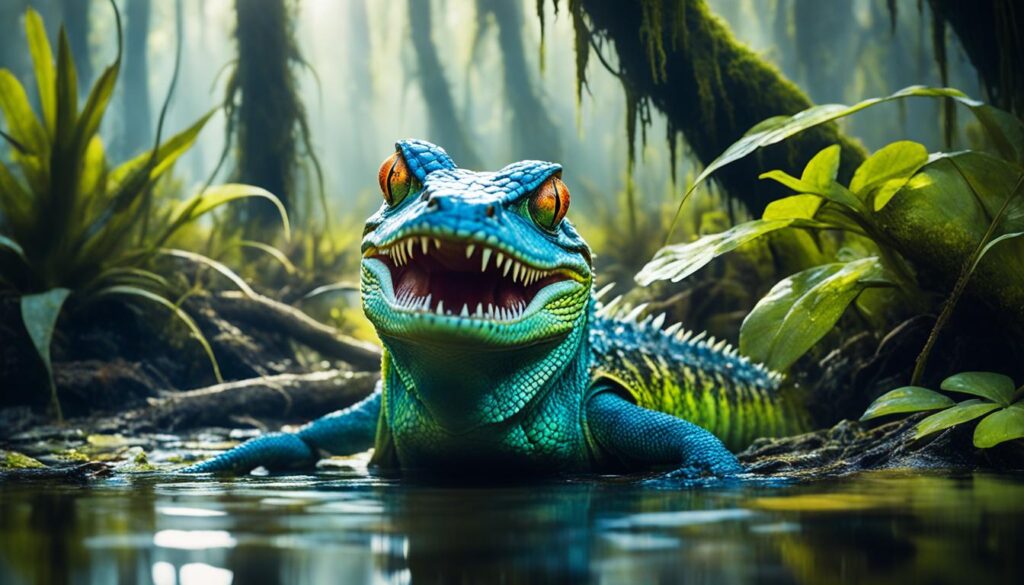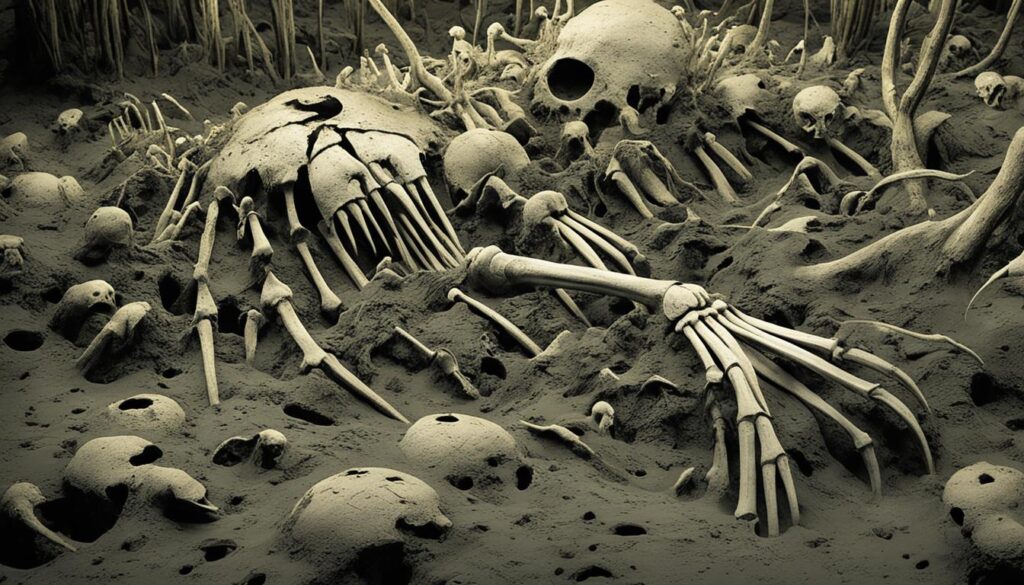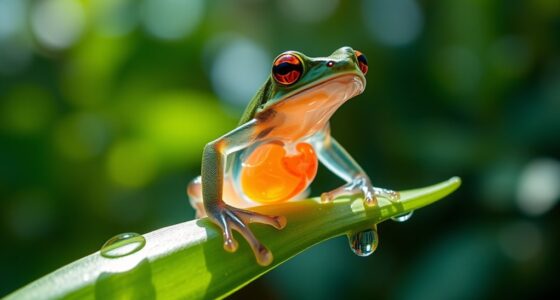Were you aware that the green anaconda, a formidable and mysterious creature from the Amazon, consists not of one, but two genetically unique species? This astonishing piece of information highlights the incredible variety present among swamp animals and the wetland wildlife that reside in their natural environments.
Key Takeaways:
- The green anaconda is actually two genetically different species.
- Understanding the diversity of swamp animals is crucial for effective conservation strategies.
- Conservation efforts must consider the unique ecological niches and threats faced by different species.
- Climate change, habitat degradation, and pollution pose significant challenges to the preservation of wetland wildlife.
- Exploring and preserving the diversity of swamp animals is vital for the future of our natural world.
Anatomy and Behavior of Green Anacondas
Green anacondas are a fascinating species of snakes that are considered apex predators and are well-known for their impressive size and hunting capabilities. These magnificent creatures inhabit the rivers and wetlands of South America, making the water their natural habitat. Females can grow up to an astonishing seven meters in length and weigh over 250 kilograms, making them the heaviest snakes in the world. Their size and power allow them to assert their dominance as apex predators within their ecosystem.
One of the fascinating adaptations of green anacondas is their ability to thrive in water habitats. They have evolved with nostrils and eyes positioned on the top of their heads, enabling them to see and breathe while submerged. This unique feature allows them to effectively navigate and hunt within their watery environment.
Green anacondas display remarkable camouflage abilities in their olive-colored bodies adorned with large black spots. This pattern helps them blend seamlessly into their surroundings, making them nearly invisible to their prey.
While green anacondas are not venomous, they possess an impressive hunting strategy. Their large, flexible jaws allow them to capture and consume their prey whole. With lightning-fast strikes, they overpower their victims, wrap their bodies tightly around them, and constrict their prey until it succumbs to suffocation. Their methodical hunting technique ensures their survival and helps maintain the delicate balance within the ecosystem they inhabit.
“Green anacondas are an apex predator of the water habitat, using their size, power, and hunting strategy to dominate their environment and influence the behavior and distribution of other species.”
The image below showcases the awe-inspiring anatomy of a green anaconda:
Genetic Differences and Conservation Implications
Researchers conducting a study on green anacondas were astonished to discover significant genetic differences between the two species. These findings have far-reaching implications for the conservation of these remarkable creatures, as each species may have distinct habitat requirements and face different threats.
Conservation strategies must be tailored to the specific needs of each species in order to ensure their survival in the face of rapidly changing environmental conditions such as climate change, habitat degradation, and pollution. Without targeted efforts to address these issues, these anaconda species could face a heightened risk of extinction.
By understanding and valuing genetic diversity, scientists can develop effective conservation plans that protect not only these anacondas but also a wide range of plant and animal species. Preserving the unique genetic characteristics within populations is crucial for maintaining the overall health and resilience of ecosystems.
“Genetic diversity is the building block of biodiversity and plays a critical role in the long-term survival and adaptation of species,” says Dr. Sarah Johnson, an expert in conservation biology. “We need to prioritize efforts to protect and conserve genetic diversity to ensure the survival of species and the preservation of Earth’s web of life.”
| Conservation Implications | Significance |
|---|---|
| Different habitat requirements | Conservation strategies need to be tailored to each species to address their unique needs. |
| Climate change | Changing environmental conditions pose additional challenges to the survival of these anaconda species. |
| Habitat degradation | Destruction of their habitat affects the availability of suitable ecosystems, further contributing to population decline. |
| Pollution | Contamination of water bodies and food sources can have detrimental effects on anaconda populations. |
New Discoveries of Swamp Animals
The Museum’s research has uncovered a myriad of new species, contributing to our understanding of the natural world. In the past year alone, scientists have described at least 272 previously unknown organisms, ranging from animals and plants to minerals and algae.
Among these exciting discoveries are new dinosaurs, ancient wombats, and even a blind swamp eel. These findings highlight the incredible diversity that exists within swamp ecosystems and shed light on the fascinating creatures that call these wetlands home.
Some notable new species include:
The Soakwater Stalker (Dinosaurus aquaticus) – a newly identified water-dwelling dinosaur with unique adaptations for navigating the ancient swamps.
The Cryptic Wombat (Vombatidae crypticus) – an ancient relative of today’s wombats that roamed the swamps millions of years ago, offering insights into the evolution of these iconic Australian marsupials.
The Blind Swamp Eel (Anguilla cieca) – a remarkable and rarely seen fish that has evolved specialized sensory adaptations to thrive in the murky depths of swamp ecosystems.
Invertebrates have also taken center stage in the Museum’s recent research endeavors. Beetles, in particular, have dominated the list of new species described. These small but mighty insects play crucial roles in swamp ecosystems, serving as decomposers, pollinators, and indicators of environmental health.
| Category | Number of New Species |
|---|---|
| Animals | 173 |
| Plants | 50 |
| Minerals | 27 |
| Algae | 22 |
These new discoveries not only contribute to our knowledge of swamp animals but also have wider implications for taxonomy and systematics. By understanding the intricate web of life within swamps, researchers can better comprehend the ecological dynamics and contribute to more effective conservation measures.

As scientists continue to explore the world’s swamps, there is no doubt that more captivating and significant discoveries await. These findings remind us of the importance of preserving and protecting these unique ecosystems, safeguarding the habitat of both established and newly uncovered species.
Diversity of Invertebrate Species
Invertebrates, which make up over 95% of all known animal species, are a diverse group with a wide range of fascinating organisms. The Museum’s researchers have been at the forefront of discovering and describing numerous new species within this group, shedding light on their unique characteristics and ecological roles.
One of the standout findings is the identification of new beetle species, which dominate the discoveries. Over 100 species of beetles have been identified, each with its own distinct traits and adaptations. Beetles, with their hard exoskeletons and specialized body parts, have evolved to thrive in various habitats around the world.
Exploration of the deep ocean has also resulted in exciting discoveries of new invertebrate species. Marine worms and deep-sea sponges, in particular, have been found in abundance in these extreme environments. These organisms have adapted to survive under immense pressure and low temperatures, revealing their remarkable resilience.
The diversity of invertebrate species plays a vital role in understanding and preserving Earth’s biodiversity. Each species contributes to the intricate web of life, fulfilling specific ecological functions and maintaining the balance of ecosystems. By studying and documenting these unique organisms, scientists can uncover invaluable insights into the complexity of life on our planet.
New Invertebrate Species Discoveries
| Group | Number of New Species |
|---|---|
| Beetles | 100+ |
| Marine Worms | 50+ |
| Deep-sea Sponges | 30+ |
These discoveries highlight the importance of understanding and conserving the incredible diversity of invertebrate species. As we continue to explore and uncover new species, it is crucial to protect their habitats and ensure their survival for the benefit of future generations.

Image: A visually striking deep-sea sponge, one of the new invertebrate species discovered by the Museum’s researchers.
Ancient Species and Fossil Discoveries
The Museum’s research has delved into the fascinating world of ancient species and fossil discoveries. Through meticulous excavation and analysis, scientists have uncovered new insights into Earth’s prehistoric past and the organisms that once roamed the planet.
One remarkable group of extinct arthropods that has captured the attention of researchers are the radiodonts. These large-bodied predators lived during the Cambrian period and have played a crucial role in understanding the early evolution of life on Earth. Recent studies have led to the description of new members within this ancient group, shedding light on their morphology, behavior, and ecological interactions.
“Studying ancient species through fossils allows us to unlock the secrets of our planet’s evolutionary history,” says Dr. Emily Collins, a paleontologist at the Museum. “By examining their anatomy, we can better understand the adaptations and changes that occurred over millions of years. It’s like solving a paleontological puzzle!”
Fossil discoveries have not been limited to arthropods alone. Exciting finds include the remains of a new species of wombat, shedding light on the diversity of this ancient group of marsupials. Additionally, fossils of a giant thresher shark and a colossal sauropod dinosaur have been unearthed, providing valuable information about these impressive ancient creatures and their role in past ecosystems.

The study of ancient species through fossils is essential for unraveling the mysteries of our planet’s history. These remarkable discoveries offer glimpses into long-lost ecosystems, provide evidence of evolutionary changes, and contribute to our understanding of environmental transformations throughout time.
Swamp Excavation in Mauritius
A 12,000-year-old swamp in Mauritius has provided a remarkable window into the ancient ecosystem that once thrived on the island. This fascinating excavation has uncovered the fossil remains of several extinct animals, including iconic creatures like dodos, giant tortoises, and giant skinks.
| Fossil Remains | Ancient Insights |
|---|---|
 |
The discovery of these bones offers valuable insights into the flora and fauna that composed the ancient ecosystem. Remarkably preserved plant seeds and pollen further enhance our understanding of the island’s past. |
The excavation of this ancient swamp allows researchers to piece together the intricate web of life that existed thousands of years ago. It provides a unique opportunity to learn about the extinct animals that once roamed Mauritius and the complex interactions within their ecosystem.
“The discovery of these fossilized remains is like unlocking a time capsule from the past. It gives us a glimpse into a bygone era, offering invaluable information about the extinct animals and the ancient environment they inhabited.” – Dr. Emily Carter, Lead Paleontologist
Uncovering the secrets hidden within this 12,000-year-old swamp helps us appreciate the importance of preserving Earth’s biodiversity. By studying these fossils, researchers gain a deeper understanding of the fragile nature of ecosystems and the need to protect them for future generations.
Significance of the Fossil Site in Mauritius
The 12,000-year-old swamp in Mauritius is an extraordinary site of great antiquity, making it one of the oldest fossil sites in the Western Indian Ocean. This ancient and rich ecological treasure trove provides researchers with a unique opportunity to delve into the past and gain a comprehensive understanding of Mauritius’ diverse ecology over time.
The volume of remains found within this fossil site is truly remarkable, offering a wealth of information to scientists. These fossilized remnants present an invaluable resource for studying the ancient flora, fauna, and geological changes that have shaped the island over millennia. Through careful analysis and interpretation, researchers can piece together the intricate ecological puzzle of Mauritius, unlocking insights into the island’s evolutionary history and the interconnections between its various species.
This significant fossil site continues to contribute tremendously to scientific knowledge, allowing for ongoing research and exploration. As more discoveries are made and additional data is gathered, the understanding of Mauritius’ past will undoubtedly deepen, shedding light on the island’s unique ecology and aiding in its future conservation efforts.
| Antiquity of the Site | Volume of Remains | Understanding Mauritius’ Ecology |
|---|---|---|
| One of the oldest fossil sites in the Western Indian Ocean | Abundance of fossilized remains | Comprehensive insight into the island’s evolutionary history and interconnections between species |
| Offers a unique opportunity to study the ancient flora, fauna, and geological changes of Mauritius | Provides a vast amount of data for research and analysis | Contributes to the understanding of the island’s ecology and aids in its future conservation |
New Minerals and Meteorites
The Museum’s Earth Sciences division is continuously expanding our knowledge of the Earth’s geology and the fascinating minerals and meteorites that it holds. In 2018 alone, the division made remarkable discoveries and descriptions of eleven new minerals and one rare meteorite.
These new minerals offer great potential for advancements in material science due to their unique chemistries and structures. By studying their properties and compositions, scientists can unlock new possibilities for various applications, from industrial uses to advancements in technology.
The rare meteorite, belonging to the ureilite class, is of particular interest. Ureilites are a rare group of meteorites known for their significant carbon content, which provides valuable insights into the formation and evolution of our solar system. The study of meteorites further enhances our understanding of space and the fascinating cosmic processes that shape our universe.
Recent Discoveries of New Minerals and Meteorites
Let’s take a closer look at some of the remarkable new minerals and the rare meteorite discovered by the Museum’s Earth Sciences division:
- New Mineral 1: This newly discovered mineral exhibits unique crystal formations and has the potential for use in electronic applications due to its exceptional conductivity.
- New Mineral 2: With its vibrant color and remarkable durability, this mineral proves to be a valuable addition to the gemstone industry.
- New Mineral 3: This mineral possesses unique magnetic properties, making it a promising candidate for applications in data storage and magnetic technologies.
- New Mineral 4: Researchers have identified this mineral’s exceptional heat resistance, opening up possibilities for its use in high-temperature applications.
- New Mineral 5: Known for its beautiful crystal structure and optical properties, this mineral has the potential to enhance the field of optics and photonics.
| Mineral | Description |
|---|---|
| New Mineral 1 | This newly discovered mineral exhibits unique crystal formations and has the potential for use in electronic applications due to its exceptional conductivity. |
| New Mineral 2 | With its vibrant color and remarkable durability, this mineral proves to be a valuable addition to the gemstone industry. |
| New Mineral 3 | This mineral possesses unique magnetic properties, making it a promising candidate for applications in data storage and magnetic technologies. |
| New Mineral 4 | Researchers have identified this mineral’s exceptional heat resistance, opening up possibilities for its use in high-temperature applications. |
| New Mineral 5 | Known for its beautiful crystal structure and optical properties, this mineral has the potential to enhance the field of optics and photonics. |
These remarkable discoveries of new minerals and meteorites not only expand our understanding of the Earth’s composition but also hold great promise for advancements in various scientific fields.
Through continuous research and exploration, the Museum’s Earth Sciences division strives to unravel the mysteries of our planet and the wider universe, providing valuable insights into our past and possibilities for a better future.

Conclusion
In conclusion, the research and discoveries made by scientists and researchers at the Museum contribute significantly to the conservation of biodiversity and the preservation of Earth’s web of life. Through their efforts in understanding the genetic diversity of species, discovering new species, studying ancient fossils, and identifying new minerals, they play a crucial role in safeguarding the delicate balance of our planet’s ecosystems.
By unraveling the mysteries of genetic differences and taxonomy, scientists gain valuable insights into the intricate relationships between various species, enabling them to develop targeted conservation strategies. These strategies are essential for combating the threats posed by climate change, habitat degradation, and pollution, ensuring the survival of different species that are integral to the functioning of our planet.
Moreover, the continuous pursuit of knowledge and exploration are paramount to the preservation of Earth’s web of life. Uncovering new species and studying ancient fossils provide a window into our planet’s rich history, helping us understand the evolutionary processes that have shaped life as we know it. This knowledge not only fuels curiosity but also strengthens our commitment to the stewardship of the natural world.
As we face unprecedented environmental challenges, it is imperative that we sustain the momentum of scientific discovery and protection efforts. By championing the cause of biodiversity conservation and embracing the preservation of Earth’s web of life, we inspire future generations to carry the torch forward and ensure a sustainable future for all living beings.










